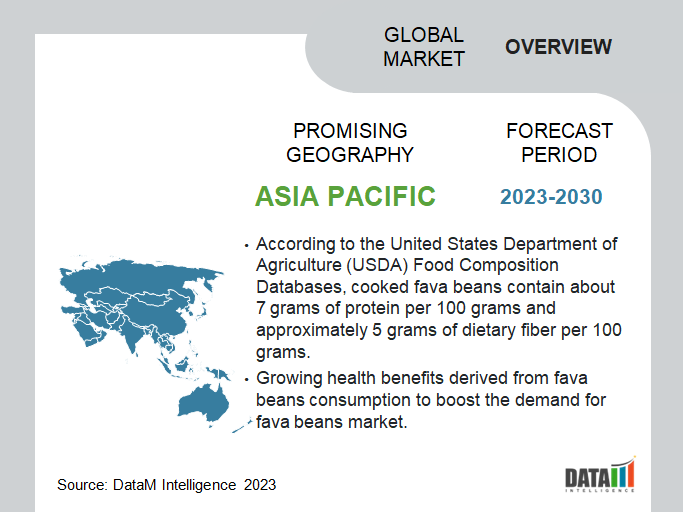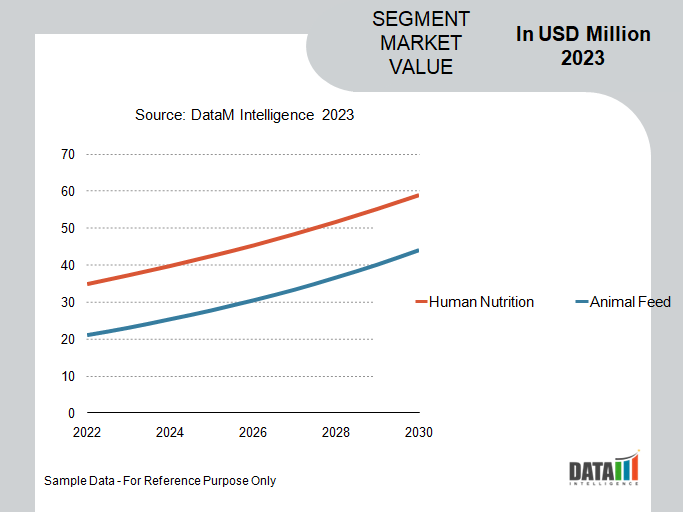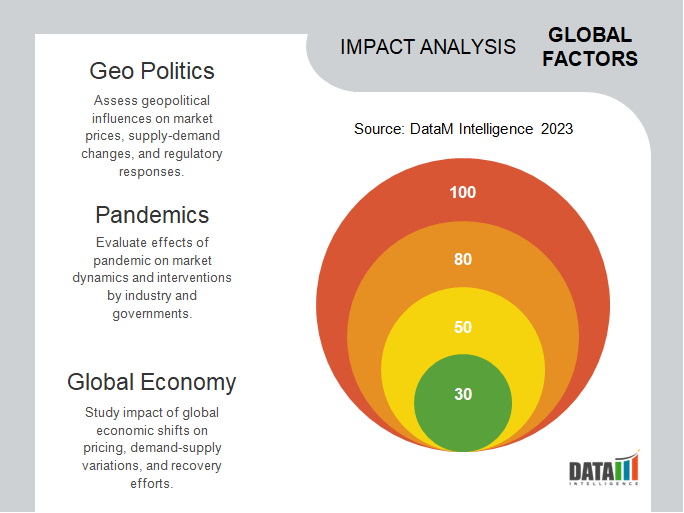Global Fava Beans Market is Segmented By Application (Human Nutrition, Animal Feed), By Distribution Channel (Supermarkets/Hypermarkets, Specialty Stores, Convenience Stores, Online Sales, Others), and By Region (North America, Europe, South America, Asia Pacific, Middle East, and Africa) – Share, Size, Outlook, and Opportunity Analysis, 2024-2031
Fava Beans Market Size
Global Fava Beans Market reached USD million in 2023 and is expected to reach USD million by 2031 growing with a high CAGR of during the forecast period 2024-2031. Vicia fava, commonly known as the broad bean, fava bean, or fava bean, is a species of vetch, a flowering plant in the pea and bean family Favaceae.
It is widely cultivated as a crop for human consumption, and also as a cover crop. Varieties with smaller, harder seeds that are fed to horses or other animals are called field bean, tic bean or tick bean. This legume is very common in Southern European, Northern European, East Asian, Latin American and North African cuisines.
Some people suffer from favism, a hemolytic response to the consumption of broad beans, a condition linked to a metabolism disorder known as G6PDD. Otherwise the beans, with the outer seed coat removed, can be eaten raw or cooked. Fava bean plays an important role as a rotation and mixed crop in improving soil fertility that helps sustainable production of cereal crops, mainly wheat and it is intercropped with vegetables, sugarcane.

Fava Beans Market Scope
|
Metrics |
Details |
|
CAGR |
High |
|
Size Available for Years |
2022-2031 |
|
Forecast Period |
2024-2031 |
|
Data Availability |
Value (US$) |
|
Segments Covered |
Application, Distribution Channel, and Region |
|
Regions Covered |
North America, Europe, Asia-Pacific, South America, and Middle East & Africa |
|
Largest Region |
Asia Pacific |
|
Report Insights Covered |
Competitive Landscape Analysis, Company Profile Analysis, Market Size, Share, Growth, Demand, Recent Developments, Mergers and Acquisitions, New Product Launches, Growth Strategies, Revenue Analysis, Porter’s Analysis, Pricing Analysis, Regulatory Analysis, Supply-Chain Analysis, and Other key Insights. |
To Know More Insights - Download Sample
Fava Beans Market Dynamics
Growing Health Benefits Derived from Fava Beans Consumption to Drive the Global Market Trends
Fava beans are an exquisite source of plant-based protein and dietary fiber. Protein is a vital nutrient for constructing and repairing tissues, and fiber aids in digestion and helps gut health. According to the United States Department of Agriculture (USDA) Food Composition Databases, cooked fava beans contain about 7 grams of protein per 100 grams and approximately 5 grams of dietary fiber per 100 grams.
Fava beans are rich in essential vitamins and minerals, including folate, vitamin C, iron, and potassium. Folate is crucial for fetal development during pregnancy and supports overall cell function. Vitamin C is an antioxidant that helps protect the body against free radicals and supports the immune system. Iron is essential for oxygen transport in the blood, and potassium is necessary for heart health and muscle function. These nutritional attributes contribute to the appeal of fava beans as a healthful food choice.
Rising Demand for Plant-Based Proteins is Expected to Drive The Fava Beans Market Growth
The food industry has been responding to the rising demand for plant-based proteins by introducing a wide range of products, such as plant-based burgers, sausages, milk alternatives, and snacks. Fava beans have been used as an ingredient in some of these products due to their protein content and versatility.
There has been a noticeable shift in consumer preferences towards plant-based diets due to various factors, including health and environmental concerns. According to a report by the World Economic Forum, plant-based diets will be essential to the planet’s future. The report says that switching en masse to a plant-based diet is essential to protect wildlife habitats and prevent the loss of numerous species currently facing extinction.
Culinary Preparations and Additional Cooking Time is Restraining the Fava Beans Market
Fava beans are not as widely known and used as other legumes in some regions. Consumers who are unfamiliar with fava beans may be unsure of how to properly prepare and cook them, leading to hesitation in purchasing or using them in recipes. Compared to some other legumes, fava beans typically have a longer cooking time, especially when starting from raw or dried beans. This can be a deterrent for consumers seeking quick and easy meal options, as they might prefer legumes that cook more rapidly.
Culinary preparations and longer cooking times can also influence the food industry's decision to include fava beans in their products or menus. Food manufacturers and restaurants may hesitate to feature fava beans due to the additional time and effort required, potentially limiting their availability to consumers.
Fava Beans Market Segment Analysis
The global fava beans market is segmented based on application, distribution channel, and region.
The Human Nutrition Segment Holds the Largest Market Share in the Fava Beans Market
Fava beans are considered a nutritious food source due to their high protein content, dietary fiber, vitamins, and minerals. They are especially valued as a plant-based protein source, making them a popular choice for consumers following vegetarian, vegan, or plant-based diets. The demand for nutritious and wholesome foods in the human nutrition sector is expected to drive the market share of fava beans in this segment.
Consumers are increasingly seeking foods that provide health benefits beyond basic nutrition. According to an article by WebMD, Fava beans consists of 1% vitamin C, 17% iron and 3% calcium, which are essential nutrients for the human body. Fava beans' potential cholesterol-lowering effects, contribution to glycemic control, and support for cardiovascular health are factors that align with the growing wellness and functional food trends. As a result, fava beans are expected to be favored in the human nutrition market.

Fava Beans Market Geographical Share
Asia Pacific is Dominating the Fava Beans Market
Fava beans have been a part of traditional diets in numerous countries within the Asia Pacific location, specifically inside the Middle East and Mediterranean areas. These nations have a long history of cultivating and consuming fava beans, leading to a deep-rooted cultural acceptance and demand for this legume.
Asia Pacific is home to a significant proportion of the world's population, which interprets to a considerable consumer base. As the population grows, so does the demand for numerous food products, including fava beans, specially with the increasing in the plant-based diets. Many nations in the Asia Pacific region have suitable climates and agricultural situations for growing fava beans.

Fava Beans Market Companies
The major global players in the market include Prairie Fava, Unigrain, Roland Beans, Aviip Group, Alberta Pulse Growers, Sun Impex B.V, Nuttee Bean Co, Dunns (Long Sutton) Limited, BI Nutraceuticals, and GrainCorp Limited.
COVID-19 Impact on Fava Beans Market
Global Recession/Ukraine-Russia War/COVID-19, and Artificial Intelligence Impact Analysis:
Covid-19 Impact:
The COVID-19 pandemic led to disruptions in global supply chains, including agricultural and food supply chains. Restrictions on movement, lockdowns, and border closures could have affected the transportation and distribution of fava beans, impacting their availability and distribution in certain regions. Changes in consumer behavior during the pandemic, such as panic buying, stockpiling of essential goods, and shifts in consumption patterns, could have influenced the demand for fava beans.

By Application
- Human Nutrition
- Animal Feed
By Distribution Channel
- Supermarkets/Hypermarkets
- Specialty Stores
- Convenience Stores
- Online Sales
- Others
By Region
- North America
- The U.S.
- Canada
- Mexico
- Europe
- Germany
- The U.K.
- France
- Italy
- Spain
- Rest of Europe
- South America
- Brazil
- Argentina
- Rest of South America
- Asia-Pacific
- China
- India
- Japan
- Australia
- Rest of Asia-Pacific
- Middle East and Africa
Key Developments
- In March 2023, Nestle opts for fava and oat blend in new alternative dairy drink. The company’s latest milk alternative combines two plant-based products to deliver higher nutrient levels.
- In October 202o, Verso Food has secured a patent covering its fava bean processing technology for plant-based foods and meat analogues. The company’s CEO Tomi Jarvenpaa said about the product development opportunities it could unlock, the group’s global aspirants and plans as business-to-business supplier.
- In January 2023, Tesco and its suppliers have launched trial uses of “revolutionary crop” the fava bean across a host of different ranges and ingredients. The retailer has partnered with fava bean processor AB Mauri and food manufacturer Samworth Brothers to include the beans in new products, increasing UK demand for the legume at the same time.
Why Purchase the Report?
- To visualize the global fava beans market segmentation based on application, distribution channel and region, as well as understand key commercial assets and players.
- Identify commercial opportunities in the market by analyzing trends and co-development.
- Excel data sheet with numerous data points of fava beans market-level with all segments.
- The PDF report consists of cogently put-together market analysis after exhaustive qualitative interviews and in-depth market study.
- Product mapping is available as Excel consists of key products of all the major market players.
The global fava beans market report would provide approximately 53 tables, 48 figures, and 190 Pages.
Target Audience 2024
- Manufacturers/ Buyers
- Industry Investors/Investment Bankers
- Research Professionals
- Emerging Companies